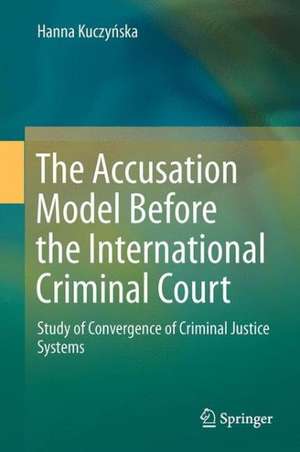The Accusation Model Before the International Criminal Court: Study of Convergence of Criminal Justice Systems
Autor Hanna Kuczyńskaen Limba Engleză Hardback – 21 mai 2015
| Toate formatele și edițiile | Preț | Express |
|---|---|---|
| Paperback (1) | 395.47 lei 6-8 săpt. | |
| Springer International Publishing – 9 oct 2016 | 395.47 lei 6-8 săpt. | |
| Hardback (1) | 402.98 lei 6-8 săpt. | |
| Springer International Publishing – 21 mai 2015 | 402.98 lei 6-8 săpt. |
Preț: 402.98 lei
Nou
Puncte Express: 604
Preț estimativ în valută:
77.12€ • 80.02$ • 64.46£
77.12€ • 80.02$ • 64.46£
Carte tipărită la comandă
Livrare economică 17-31 martie
Preluare comenzi: 021 569.72.76
Specificații
ISBN-13: 9783319176253
ISBN-10: 3319176250
Pagini: 300
Ilustrații: XIII, 409 p.
Dimensiuni: 155 x 235 x 27 mm
Greutate: 0.77 kg
Ediția:2015
Editura: Springer International Publishing
Colecția Springer
Locul publicării:Cham, Switzerland
ISBN-10: 3319176250
Pagini: 300
Ilustrații: XIII, 409 p.
Dimensiuni: 155 x 235 x 27 mm
Greutate: 0.77 kg
Ediția:2015
Editura: Springer International Publishing
Colecția Springer
Locul publicării:Cham, Switzerland
Public țintă
ResearchCuprins
The procedure before international criminal tribunals.- Prosecutor as an organ of international criminal tribunals.- Initiation of an investigation.- Judicial control of an accusation.- Obligations of the prosecutor related to the accused's right to information.- Influence of the prosecutor on the consensual termination of criminal proceedings.- Powers of the prosecutor before the Trial Chamber.- Powers of the prosecutor in the appeal proceedings.- Conclusion.
Textul de pe ultima copertă
This book examines how the functioning of the International Criminal Court has become a forum of convergence between the common law and civil law criminal justice systems. Four countries were selected as primary examples of these two legal traditions: the United States, England and Wales, Germany and Poland.
The first layer of analysis focuses on selected elements of the model of accusation that are crucial to the model adopted by the ICC. These are: development of the notion of the prosecutor’s independence in view of their ties to the countries and the Security Council; the nature and limits of the prosecutor’s discretional powers to initiate proceedings before the ICC; the reasons behind the prosecutor’s choice of both defendants and charges; the role the prosecutor plays in the procedure of disclosure of evidence and consensual termination of proceedings; and the determinants of the model of accusation used during trial and appeal proceedings.
The second layer of the book consists in an analysis of the motives behind applying particular solutions to create the model of accusation before the ICC. It also shows how the model of accusation gradually evolved in proceedings before the military and ad hoc tribunals: ICTY and ICTR. Moreover, the question of compatibility of procedural institutions is addressed: In what ways does adopting a certain element of criminal procedure, e.g. discretional powers of the prosecutor to initiate criminal proceedings, influence the remaining procedural elements, e.g. the existence of the dossier of a case or the powers of a judge to change the legal classification of the criminal behavior appearing in the indictment?
The first layer of analysis focuses on selected elements of the model of accusation that are crucial to the model adopted by the ICC. These are: development of the notion of the prosecutor’s independence in view of their ties to the countries and the Security Council; the nature and limits of the prosecutor’s discretional powers to initiate proceedings before the ICC; the reasons behind the prosecutor’s choice of both defendants and charges; the role the prosecutor plays in the procedure of disclosure of evidence and consensual termination of proceedings; and the determinants of the model of accusation used during trial and appeal proceedings.
The second layer of the book consists in an analysis of the motives behind applying particular solutions to create the model of accusation before the ICC. It also shows how the model of accusation gradually evolved in proceedings before the military and ad hoc tribunals: ICTY and ICTR. Moreover, the question of compatibility of procedural institutions is addressed: In what ways does adopting a certain element of criminal procedure, e.g. discretional powers of the prosecutor to initiate criminal proceedings, influence the remaining procedural elements, e.g. the existence of the dossier of a case or the powers of a judge to change the legal classification of the criminal behavior appearing in the indictment?
Caracteristici
Examines the prosecution model used before the ICC from a comparative point of view Highlights elements of the prosecution model used in four different countries and before the ad hoc tribunals and the ICC, and explains why a certain structure of prosecution has been used before the ICC Addresses questions on the main differences between the civil law and common law judicial systems, and on how changing one of the institutions of criminal procedure influences the remaining institutions















